I’ll be the first to admit, I am not the most knowledgeable soccer/football fan. I played it as a kid, followed it, although not too closely, when I lived in Europe in the 80’s, and while I know of the Premier League, Bundesliga and the like, until about 2017, my knowledge of world football was, at best, a PowerPoint slide or two deep. As an American, soccer/football just wasn’t something I followed too closely.
I am a gamer though. Board, miniatures, computer, pen and paper, dice, that was (and still is) a hobby of mine. There’s a Youtuber I follow named Quill18, who does a lot of “Let’s Plays” for various games I also play, and one day his followers challenged him to play FM17. And he did. And I sat there the whole time watching him play with a quizzical look of “What the hell is this and where has it been my life?” I know Madden, I like Madden and other sports games (Heck I was a Tecmo Bowl League my sophomore year of college, and yes, that makes me old), never played FIFA (because, well, Soccer…), but Football Manager was more than either of them. So, so much more.
So I bought it, and started to learn it. And two and a half years later, a couple of thousand watched videos on YouTube, and countless hours of streams by other content creators, it has become the game I play most. Like many games, it’s very customizable in the detail level you want, how much control you’d like. For most FM17, and most of FM18, I was a hands off coach. Tactics, some scouting, and press conferences, that was it. I spent a decent amount of time following up the scouts recommendations, but I never too full control of the club I was running.
That’s changed with FM19. After my initial Beta Test save (with Crystal Palace), I knew what save I wanted to do, and I also knew I wanted to exercise more control over, well, everything. But I needed some help to get that done.
In my day job, I’m a Geographer/GIS Analyst. I take data and represent it visually. Lot’s, and lots of data, and shapes, and details. I do also get to make some cools maps (Aswijan for example), but really, 75% to 90% of my job is manipulating data and making it not only understandable to the end user, but accurate as well. There’s a lot going on behind the scenes, and the end user will only see the last 10% or so of your efforts, but it’s the other 90% that makes things go.
On top of this, I am what I like to refer to as a “Least Amount of Effort” type of person. While that sounds bad, in actuality what it means is that if given a task, I’m not going to take any shortcuts to finish it, and I’m not going to add any chrome to it to make it flashier. If a job requires ten steps to get done, I’m going to do it ten steps. Not six, not fifteen, but ten.
I’ve been on projects with those sorts of people who do both. I’m not a fan.
I work with a lot of tables, and spreadsheets, and I like to be my job as easy as possible, so I will manipulate them to try and make my life easier. When it works, it’s great. When it doesn’t, well, thank god for CTRL-Z.
Early on, one of the things I wanted to do in FM17 with my first main save, was track how my players attributes improved. One of the things Football Manager is good at is the data it creates for, well, most everything. One of the things it’s not so great at is representing that data usefully. While that is a criticism, I understand why SI have done the things they have done when it comes to data and how they present it. But they do make it easy to export a lot of data, and with a little application of application, there are some things a manager can do to make his job a little easier. And that what I set out to do.
This is Sophiane Bouris Belle. He’s my very good youth striker in my current save with SC Bastia:
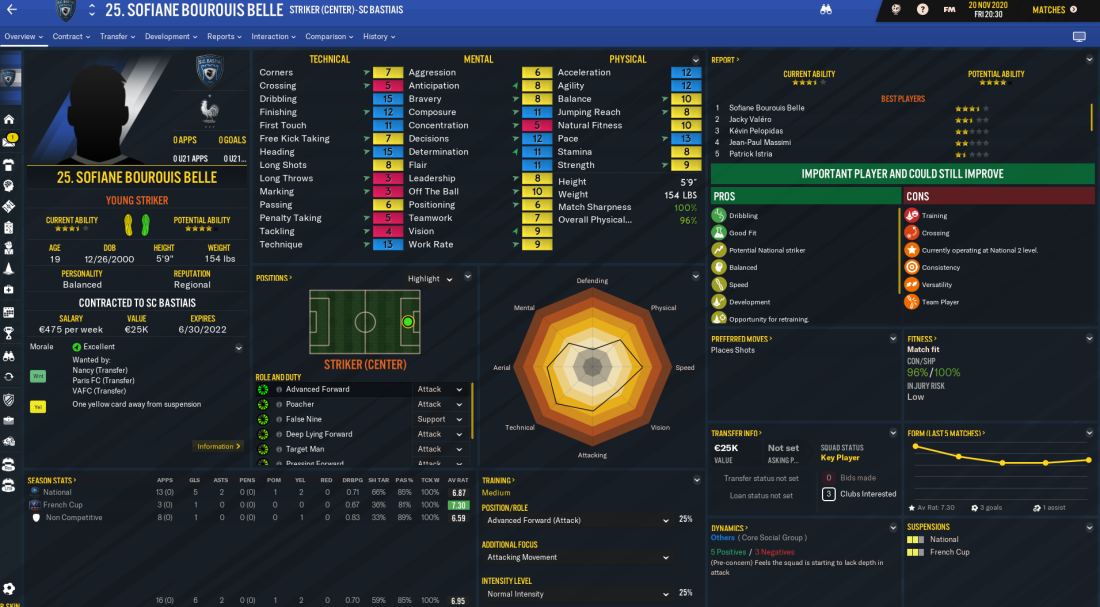
There’s a lot of data here, and a lot of it is quite useable. Attributed wise, I can tell by the little green arrows next to most of them that he is improving in all those areas. How much? Well, that’s where I run into some issues.
Clicking on Development→Attribute Changes gives you this screen:
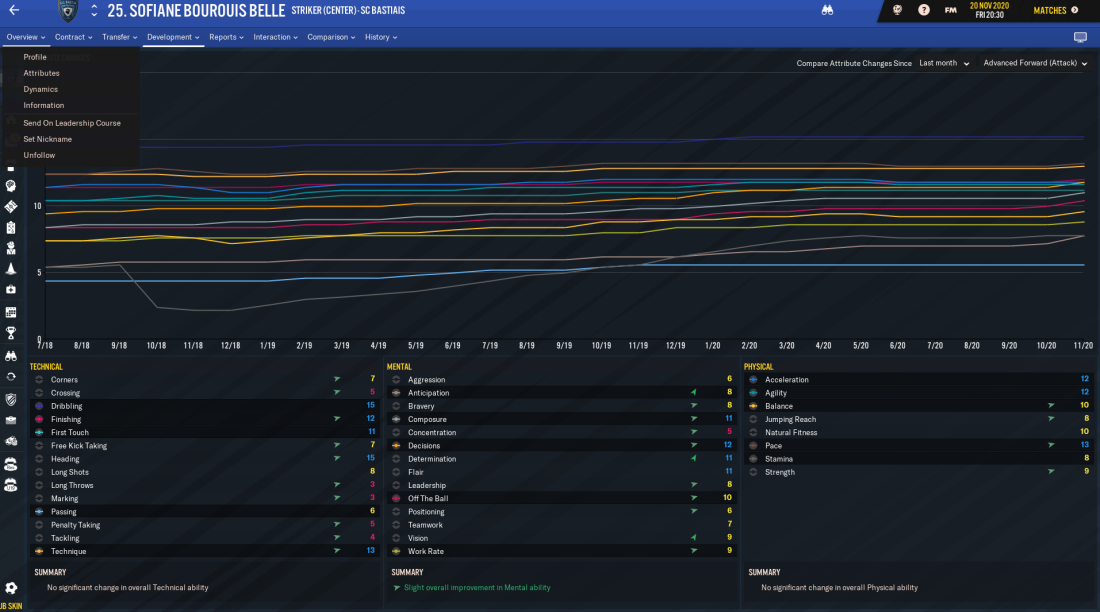
And it’s not bad, just incomplete, at least for what I want to do. Especially when you consider that if you turn on all the Attributes you get this:
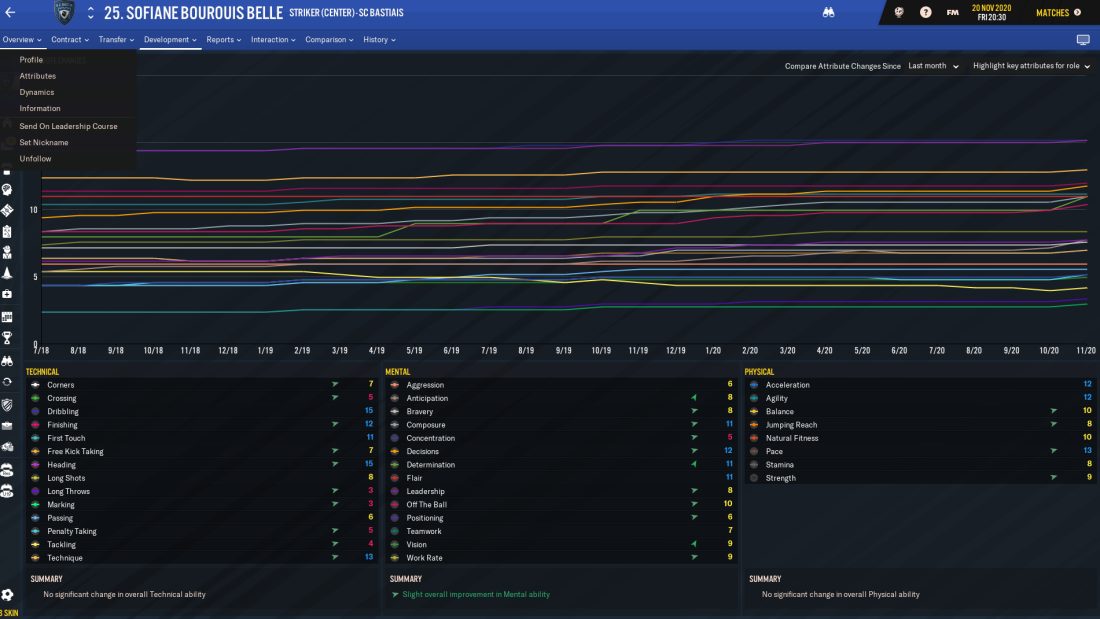
On some players, if you relax one eye you can see the sailboat…
But there’s better way of seeing these changes, at least for me.
First, you have to create a Squad View of all the Attributes. And make sure the column order of this view is the same order as the player attributes. And do not mess with the columns after creating this view, or you will make a mistake. Yes, that’s from experience. You can add other items of info you want to the end, I find that makes it easier, but YMMV.

Now, open your spreadsheet program. I use Calc by Libreoffice, but I have it set up to use Excel formulas, so what follows should work without a problem on Excel.
Now, go back into Football Manager, and under the FM button, scroll down to ‘Print Screen’ and Print as a Web Page, Select the folder you want to save it to, rename the file, to whatever you want, and click ‘Save’.
Helpful hint, if you have a set folder where you want all this data to go to, the next time you get to this screen, hit the ‘Recent’ drop down on the right, and a list of folders you’ve recently used, including the one your exported data is going into, should pop up.
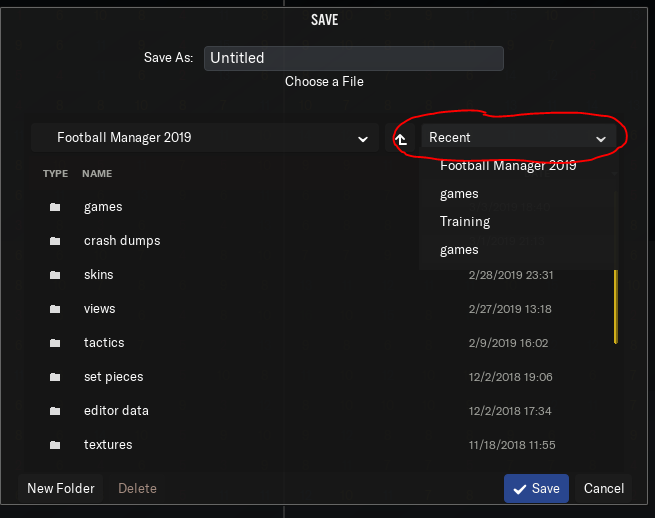
Navigate to that folder, click the file, and it will open in your browser.

Select the data you want, copy it, go to your blank spreadsheet, select the cell you want the data to start in, and then this is very, very important:
Right Click, select Paste Special, and then select ‘Unformatted Text’
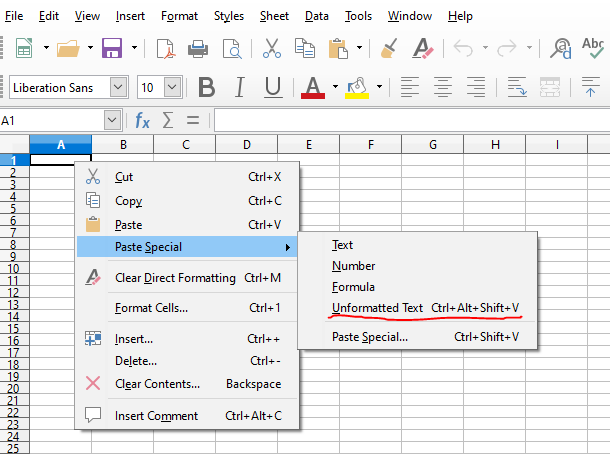
This is very important, if you do not do this some formulas and calculations will not work!
This has to do with how Excel/Calc ‘see’s’ and interprets whats in the cell. Sometimes it sees ‘12345’ as a number, sometimes it sees it as text. Sometimes it will not ‘see’ text in a cell as part of a calculation, this is due to the cells format. Pasting everything in as ‘Unformatted Text’ should default most text to text, and numbers to numbers. There may be cases where you will have to go into the spreadsheet and set a cells format, but most of those occur later.
When you paste, you’ll get this:

And you can format this however you want. You will also want to rename the tab. I rename it whatever month I took the Attribute Screen Shot.

The next time you export an Attribute Screen Shot, create a second tab, cut and past the data the same way, and rename the tab.
NOTE: Your Attribute Screenshot does not have to have the names in the same order each time you take it. I promise.
Now comes the cool stuff: Conditional Formatting.
A conditional format is a rule you set up for data on the page, and that rule says that if a cell, or group of cells, is equal to the condition you set, whatever change you want to apply to that data will be applied.
Changes can range from font changes, to color changes, to both. You can have multiple conditional formats on a page, but you have to be careful how you apply them, as there is a priority/hierarchy to how they are applied.
Create a conditional format, set the condition to Formula Is and enter in the following formula:
C3<(VLOOKUP($A3,TAB!$A$2:$AL$99,COLUMN(),0)-1)
What I set for the style is to change the cell color to Red.
Now, an explanation of this formula, and what yoy may have to change to get it to work on your spreadsheet:
C3 is the first cell you want the formula to start looking at. Don’t use C2 if it’s your first line of data, the formula doesn’t like it. I’m not sure why.
A3 is the cell your Players Name is in.
TAB! is the name of the tab you want searched.
A$2:$AL$99 is the range of data being searched on the tab. This also means it will search all the data and names, including the first row.
So what this formula is saying is this:
Look at Cell C3. Compare it Value to the Value of the Cell where the name of the player in A3 of whatever tab your referencing; if that name isn’t in A3 search for it A2 to AL99, and once found, compare the numbers in the columns between the two tabs. If the number in tab2 is less than the number in tab1 by -2 (or more), turn the cell red. Clear as mud, right? I’m not sure how I could explain it better, any suggestions would be great!
The next formula should be:
C3>(VLOOKUP($A3,TAB!$A$2:$AL$99,COLUMN(),0)+1)
I set this to turn the cell dark green. This is looking for Values that are +2 or more that have changed between tabs.
Next formula is:
C3<(VLOOKUP($A3,TAB!$A$2:$AL$99,COLUMN(),0))
This is looking for Values that are -1 from Tab2 to Tab1, I set this to change the background to Yellow.
The last formula is
C3>(VLOOKUP($A3,TAB!$A$2:$AL$99,COLUMN(),0))
This is looking for Values that are +1 from Tab2 to Tab1, I set this to change the background to a lighter Green.
These formulas have to be entered in this order, when you arrange them in the condition box it has to read +2, -2, +1, -1.
This is because Excel and Calc are very hierarchy oriented, so if you have the -1 rule at the top, when the formatting formula is looking, it will see 8 is at least 1 less than 10, and turn it yellow, and because a condition has already been applied, it will not turn it read when it goes to apply the -2 change.
Once you have the formulas entered, hit ok/apply, they should take effect, and this:
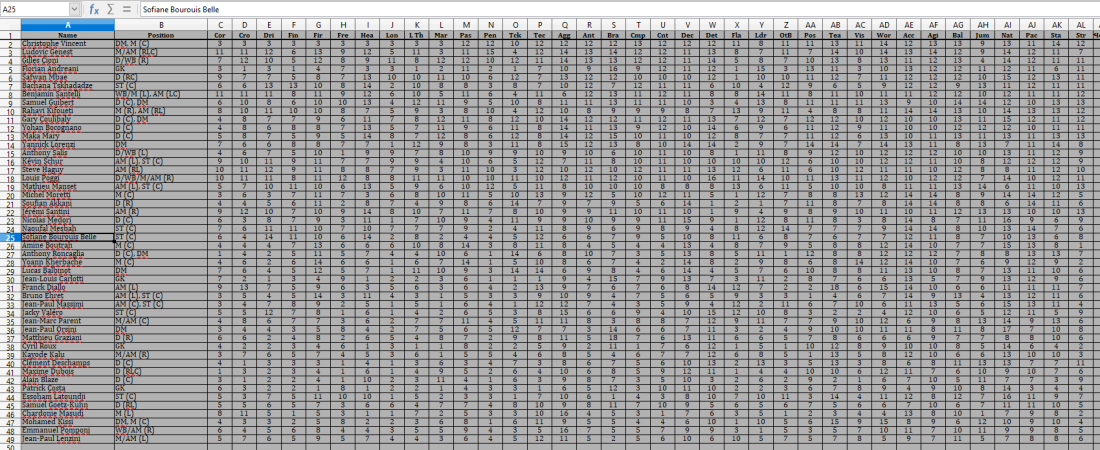
Should turn into something like this:
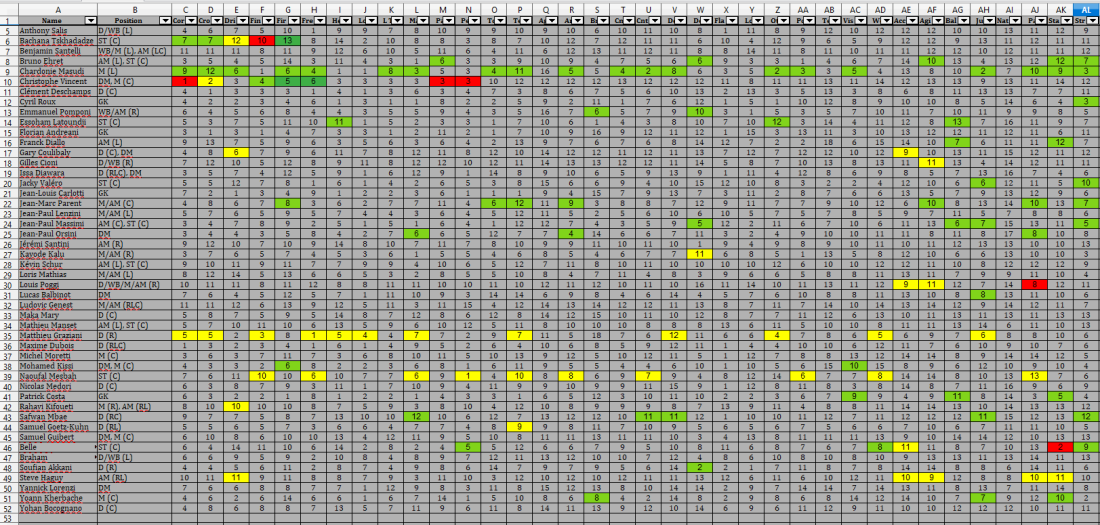
When you need additional tabs, what I do is right click on an already filled out tab with the conditional formatting applied, copy it with a new name to the spreadsheet, then delete the names and data on the page. That way the formatting stays behind. The only thing you have to do now is go into the conditional formatting formulas and change the tab you want referenced.
One last note, which I mentioned before:
DO NOT MOVE ANY COLUMNS AROUND BETWEEN SCREEN SHOTS!
The formula used does not look at the column headers, but the Player Name, and once it finds the match, it will start comparing the values of the columns associated with that name from left to right. If you move the columns around between screenshots and apply the formula, you will get some strange results. I once couldn’t figure out how all on my players Physicals dropped -2, then found out I had deleted a column…
And that’s also the very cool thing about this formula, it looks at the name before it starts comparing. No matter where it is in the name column, if in your tab2 it finds the name in tab1, it will compare the numbers and apply the formatting.
As proof of this, the above is taken with the names in Ascending order.
This is a screenshot of the same tab with the names I descending order:
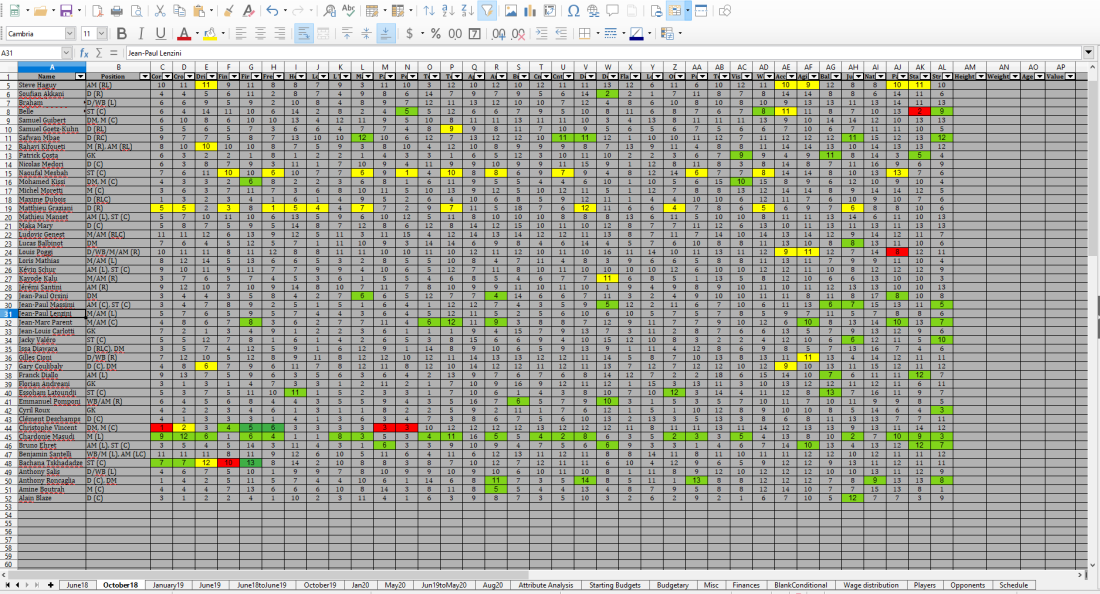
You’ll notice the formatting has moved with the player.
🙂
I’ve found this very useful for tracking not only my players growth every three or so months, but it’s also coming in quite handy as a training session aid as well. If my players are improving quite a bit in say their technical skills, but not their physical skills, I know I should start emphasizing more physically oriented training sessions. Likewise, it will show my youth players development, and when my older players start declining. This is a screenshot of my squad, comparing their progress from June of 2018 to June of 2019.
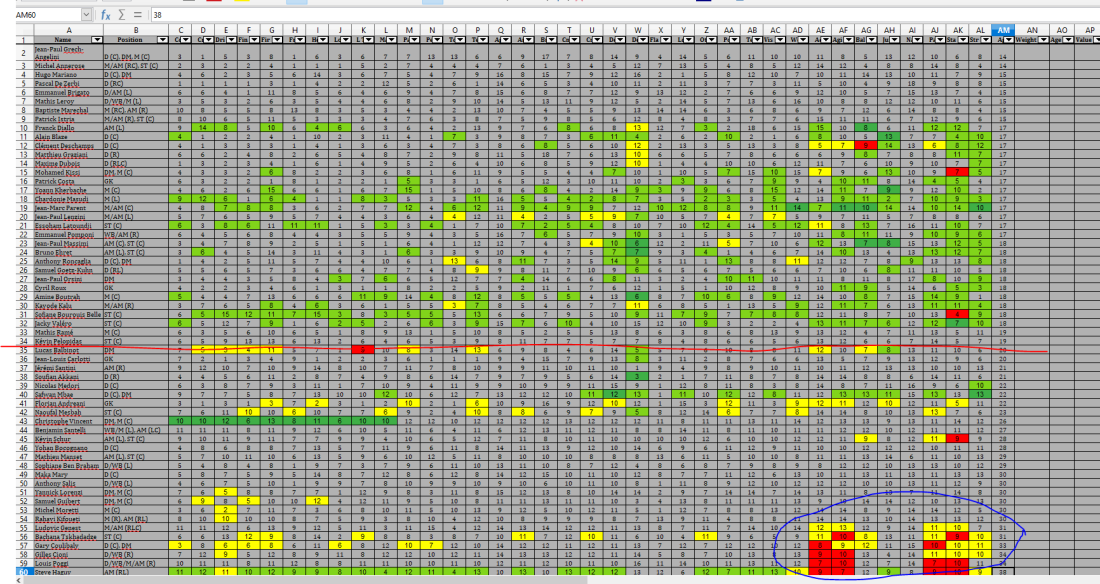
Everybody above the red line is a youth player.
The stats circled in blue are the physicals of my players aged 31 and older.
A little bit easier to interpret than a bar graph, right?
And that’s going to be it for Part 1 of this series. I don’t know how long it’s going to be to be honest, but I do know the next couple of parts are going to be the Attribute Analysis comparison graph, the Wage Budget Calculator I use, and the Schedule Tab, and all the things you can do with it.
A big thanks to the people over at the MrExcel forums (MrExcel.com) for help with a lot of the formulas used in this project.
Thanks for reading, and if there’s something you’d like to see please let me know.
FM_Jellico
Find me @FM_Jellico on Twitter!
Hey..
I’m trying to use the excel spread sheet, but i don’t know where i change the rules, so i can change a new sheet comparing from Juli to September instead.. I thought i should be under “home ->” Conditional formatting, and then manage rules -> edit rules.. But i can’t make it work.. Am i doing something wrong??
LikeLike
You have to change the conditional formatting on each tab. So if you have a july sheet, copy it and rename it September, you have to go into the conditional formatting on the September sheet and change the formula there.
Hope that helps, if not let me know.
LikeLike
all this time used for gaming. do you want to use time spent on football manager as an analist for Khovd Western Football Academy in Mongolia. for real pay and real work. contact our facebook page if you are interested. https://www.facebook.com/westernfc.academy
i am dead serious. just like you i played championship manager for many years. and wanted to apply that knowledge into real life football academy.
LikeLike